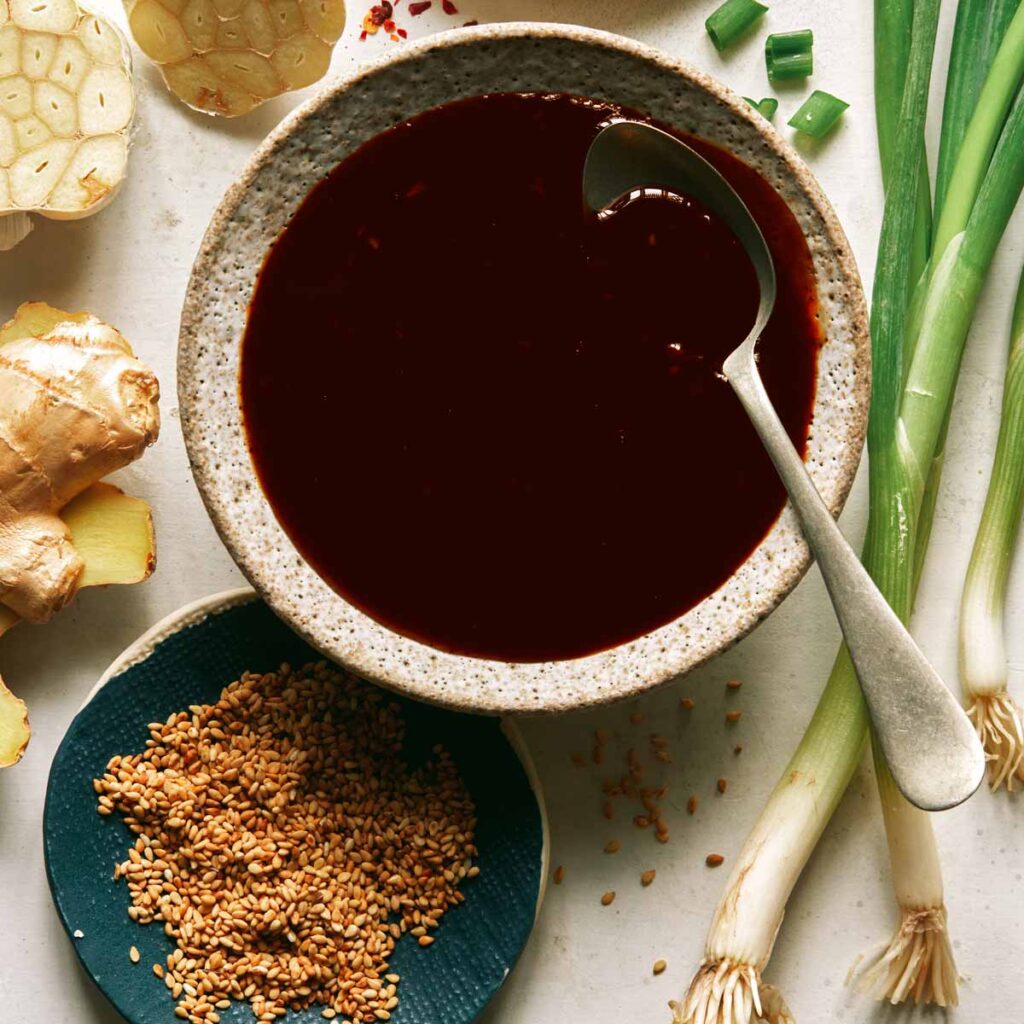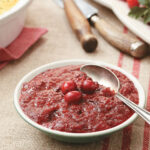Teriyaki sauce, with its perfect blend of sweetness and saltiness, has become a star in the world of grilling. Whether you’re grilling chicken, beef, or even vegetables, teriyaki sauce can elevate your barbecue to new heights.
I. The Origins of Teriyaki Sauce
The long history of teriyaki can be traced back to Japan. The word “Teriyaki” in Japanese means “glaze and grill,” and its origins are far from modern barbecue. Initially, teriyaki sauce had a practical purpose: preserving fish. In an era without refrigeration, the Japanese needed a way to make fish last longer.
Traditional methods of preserving fish included pickling and drying, but this made the fish quite unappetizing. To improve the taste and texture, chefs in Japan’s Edo period (17th to 19th century) began experimenting with different seasonings. They discovered that brushing a mixture of soy sauce, sake (rice wine), and mirin (a sweet rice wine) onto fish while grilling could infuse the fish with delightful flavors while extending its shelf life.
The sweet, savory, and slightly smoky flavors of teriyaki sauce quickly won over the Japanese palate. This culinary innovation, originally aimed at preserving fish, soon expanded to other meats beyond fish, especially chicken and beef. It was during this transition from preserving fish to grilling various meats that teriyaki sauce transformed into the beloved barbecue sauce we know today, gradually becoming a staple in Japanese cuisine and eventually spreading to other parts of the world.

II. Key Ingredients and Their Significance
To truly master the art of grilling with teriyaki sauce, you need to delve into the core ingredients that define the perfect balance of sweetness and saltiness that teriyaki sauce is known for.
Soy Sauce
Soy sauce is the cornerstone of teriyaki sauce, providing essential depth of umami and saltiness that underpin its flavor profile. It is made from fermented soybeans and wheat, lending complex, rich flavors that enhance the sauce’s depth. Soy sauce in teriyaki sauce acts like a conductor in an orchestra, coordinating the various flavors of the other ingredients.
Sake
Sake is a Japanese rice wine that brings aroma and complexity to teriyaki sauce. It is made from rice and water through fermentation. Sake’s natural sugars provide subtle sweetness that balances the saltiness of soy sauce. This sweetness, combined with the umami of soy sauce, creates the signature sweet and salty harmony of the sauce.
Mirin
Mirin is another type of rice wine crucial for adding gloss and sweetness to teriyaki sauce. Its syrupy consistency makes it an ideal choice for creating a glaze, and its sweetness enhances the overall flavor. Mirin’s role ensures that teriyaki sauce adheres to the meat, imparting a delightful sheen and irresistible taste.
Sugar
Teriyaki sauce contains sugar, usually in the form of white or brown sugar. Sugar serves a dual purpose in the sauce. First, it enhances sweetness in conjunction with mirin and sake. Second, when used during the grilling process, it helps caramelize, giving the meat a delicious glaze and a hint of smokiness.
Ginger
Fresh ginger adds aroma and spiciness to teriyaki sauce. It provides subtle heat and a bright, fresh flavor that goes beyond the richness of other ingredients. Ginger adds complexity and depth, making the sauce more vibrant and rounded.

III. Making the Perfect Teriyaki Sauce
Creating the perfect teriyaki sauce from scratch is not only achievable but also incredibly satisfying. Whether you’re an experienced chef or a kitchen novice, you can tailor your teriyaki sauce to your taste preferences and take your grilling to a new level.
Gather Ingredients
Before you start making teriyaki sauce, gather the necessary ingredients:
- 50ml soy sauce: Choose high-quality soy sauce as it forms the foundation of the sauce.
- 25ml sake: Select well-balanced sake, as it adds sweetness and complexity to the sauce.
- 25ml mirin: Look for authentic mirin as it imparts a unique gloss and sweetness to the sauce.
- 2 tablespoons sugar: Use white or brown sugar based on your preference. Brown sugar adds a hint of molasses-like depth.
- 1.5 teaspoons fresh ginger: Fresh ginger brings vibrancy and liveliness.
Cooking Process
Follow these steps to make the perfect teriyaki sauce:
- In a saucepan, mix together soy sauce, sake, and mirin.
- Add sugar for seasoning, starting with 2 tablespoons, and adjust according to your desired sweetness. Remember that sugar also contributes to the sauce’s glazing properties.
- Grate or finely chop fresh ginger and add one to two teaspoons to the mixture. Adjust the amount according to your preference for ginger spiciness.
- Place the saucepan over medium heat and stir the mixture until the sugar completely dissolves.
- After the sugar has dissolved, reduce the heat and simmer the sauce. Let it simmer for 3-5 minutes or until it thickens to your desired consistency. Stir occasionally to prevent burning.
Adjusting Consistency and Flavor
While simmering, pay close attention to the sauce’s consistency. If it becomes too thick, you can add a little water or sake to thin it out. Conversely, if it’s too thin, simmer it a bit longer.
Taste the teriyaki sauce as you cook and adjust the flavor according to your preference. If you like it sweeter, add more sugar; for a deeper umami flavor, add more soy sauce. This customization ensures your teriyaki sauce perfectly matches your grilling vision.
Cooling and Storage
Once the teriyaki sauce reaches the desired thickness and flavor, remove it from heat and let it cool. It will continue to thicken slightly as it cools.
After cooling, transfer the sauce to an airtight container. Store it in the refrigerator for up to two weeks. Over time, the flavors will continue to meld, making it even more delicious.

IV. Variations of Teriyaki Sauce
While traditional teriyaki sauce is undeniably delicious, it’s important to know that there’s a world of teriyaki sauce variations waiting for us to explore. These regional and cultural twists on the classic sauce can add unique flavors and dimensions to your grilling experience. Let’s delve into some of the most exciting variations of teriyaki sauce:
Hawaiian Teriyaki
Hawaiian teriyaki sauce is known for its tropical flavors. In addition to the core teriyaki ingredients, it incorporates pineapple juice. The natural sweetness of pineapple infuses the sauce with fruity and rich flavors, making it perfect for marinating chicken or pork. During grilling, the sugars in the pineapple juice beautifully caramelize, creating an enticing glaze.
Korean Teriyaki (Bulgogi Marinade)
In Korea, the form of teriyaki sauce is slightly different and is known as bulgogi marinade. Bulgogi marinade includes soy sauce, sugar, sesame oil, garlic, and grated Asian pear. The pear not only adds sweetness but also tenderizes the meat. Bulgogi marinade is excellent for marinating thinly sliced beef or pork, resulting in tender and flavorful grilled dishes.
Spicy Teriyaki
For those who enjoy spice, consider adding red chili flakes, Sriracha sauce, or chili paste to your teriyaki sauce. These spicy elements contrast sharply with the sweetness and saltiness of the base, creating a bold and exciting flavor. Spicy teriyaki is perfect for grilled chicken wings or shrimp, delivering a fiery kick.
Sesame Teriyaki
To introduce delightful nutty flavors and texture to your teriyaki sauce, consider adding toasted sesame seeds. These seeds complement the sweetness and saltiness of the sauce, creating a richer and more complex flavor profile. Try it with teriyaki salmon or tofu for a pleasing taste experience.
Citrus Zest Teriyaki
Enhance your teriyaki sauce with the flavors of citrus fruits like oranges or lemons. The bright citrus notes contrast with the sauce’s richness. This variation pairs wonderfully with grilled vegetables or seafood, infusing your grilling experience with vibrancy.
Don’t hesitate to get creative and blend teriyaki sauce with other international flavors. For instance, in addition to the variations mentioned above, you can experiment with combining teriyaki and classic barbecue sauce elements like honey, tomato, and vinegar for a fusion of flavors.
V. Using Teriyaki Sauce
Like other barbecue sauces, you can use teriyaki sauce in many ways.
Marinating with Teriyaki Sauce
Marinating meat with teriyaki sauce is the secret to tender and flavorful grilled meats. Let the meat soak in the sauce for at least an hour (or even overnight) to infuse it with the sweetness and saltiness of teriyaki.
Cooking with Teriyaki Sauce
When grilling with teriyaki sauce, brush it onto the meat in the final few minutes of cooking. This will caramelize the sauce and create an enticing glaze. Pair the teriyaki-marinated meats with grilled pineapple or bell peppers for a complete barbecue experience.
Using Teriyaki Sauce as a Dip or Topping
Teriyaki sauce is not only suitable for traditional grilling but also for using as a finishing touch alongside dishes. You can try incorporating teriyaki flavor into dishes like corn fritters, sandwiches, or even pizza to create unique and delicious meals.
Mastering the Art of Teriyaki Glazing
By adding more sugar, you can turn teriyaki sauce into a smooth glaze that creates an enticing sheen on the surface of your dishes.
VI. Common Mistakes to Avoid
While making teriyaki sauce for grilling can be a delightful culinary journey, many chefs encounter common pitfalls. By being aware of these mistakes, you can ensure that your teriyaki grilling experience is a great success. Here are some errors to watch out for:
Over-marinating or Under-marinating
One of the most common mistakes when using teriyaki sauce is improper marinating time. While marinating imparts flavor, over-marinating can lead to overly salty or intense flavors, depending on the thickness and type of meat. For thicker cuts of meat, longer marinating times may be beneficial, even marinating overnight, but for thinly sliced meats, marinating for half an hour to a few hours is usually sufficient. Balance is key.
Skipping the Taste Test
Recipes for teriyaki sauce often serve as a starting point, and it’s crucial to taste and adjust the sauce according to your preferences. If it’s too salty, add a bit of water or more mirin or sugar to balance it out. Conversely, if you prefer a stronger flavor, increase the amount of soy sauce. The key is to achieve a harmonious balance between sweet, salty, and savory. Be sure to taste the sauce before using it; otherwise, your grilled dishes may not taste as you like.
Skipping the Reduction Step
After all the ingredients in teriyaki sauce have dissolved, you need to simmer it over low heat for some time, which is crucial for both texture and flavor. It thickens the sauce, helps it cling to the meat during grilling, and enhances the flavor. Skipping this step can result in a thin sauce with less than optimal flavor. Be patient and let the sauce simmer slowly until it reaches your desired thickness.
Using Low-Quality Soy Sauce
The quality of soy sauce significantly impacts the final flavor of teriyaki sauce. Choose high-quality soy sauce, such as Japanese soy sauce or naturally brewed soy sauce. Inferior soy sauce may contain excessive salt or additives that can disrupt the balance of the sauce.
Neglecting the Importance of Fresh Ingredients
Using fresh ginger and other fresh ingredients is crucial for creating vibrant and authentic teriyaki flavor. Avoid using powdered or processed substitutes as they lack the aromatic complexity of fresh ginger. Fresh ingredients contribute to the overall quality and depth of the sauce.
Applying Sauce Too Early
When grilling, apply the sauce to the meat in the final few minutes of cooking. Applying it too early can result in the sugars in the sauce burning and developing a bitter taste. Brush on the sauce just before the meat is fully cooked to achieve a beautiful glaze.
Ignoring Resting Time
Allowing grilled meat to rest before serving is a crucial step. Resting allows the juices inside the meat to redistribute towards the drier outer portions, ensuring that all parts of the meat are tender and juicy. Rushing to slice and serve immediately can lead to drier meat that no amount of teriyaki sauce can fully remedy.
VII. Pairing Teriyaki Grilling with Beverages
Pairing the right beverages with teriyaki grilling can enhance your dining experience, complement the flavors, and complement your meal. Whether you prefer alcoholic or non-alcoholic beverages, here’s a guide to help you choose the perfect drink to accompany your teriyaki grilled dishes:
Crisp Beer or Pilsner
For classic pairings with teriyaki chicken or pork, consider a refreshing beer or pilsner. The clean, crisp flavors of these beers help cut through the sweetness of the teriyaki sauce, providing a harmonious balance.
Fruit-forward White Wine
Wines like Riesling, Gewürztraminer, or Sauvignon Blanc work well with teriyaki seafood or grilled chicken. The wine’s sweetness complements the sweetness of the sauce, while its acidity balances the richness of the dishes.
Rosé Wine
Rosé wine offers versatility and a refreshing quality that pairs well with various teriyaki dishes. Its acidity and fruitiness can complement the sweetness of the sauce while adding a touch of complexity.
Sake
For an authentic Japanese experience, enjoy teriyaki grilling with sake. Sake’s clean, crisp, slightly sweet profile pairs perfectly with teriyaki sauce. Consider serving it chilled or at room temperature, depending on your preference.
Citrusy IPA or Light Ale
If you enjoy hoppy beers, consider an IPA or a light ale with citrus notes. These beers can stand up to the bold flavors of teriyaki beef or grilled portobello mushrooms, creating a delightful contrast.
Non-Alcoholic Options
For those who prefer non-alcoholic beverages or want options suitable for all ages, there are several good choices:
- Iced Green Tea: The mild bitterness and herbal notes of green tea can complement the sweetness and saltiness of teriyaki sauce.
- Citrus Sparkling Water: Refreshing sparkling water with added lemon or lime can cleanse your palate between bites of teriyaki grilled dishes.
- Fruit Infused Cold Brew Tea: Create your own non-alcoholic fruit-infused cold brew tea with combinations like cucumber and mint, strawberry and basil, or other refreshing options.
Cocktails
If you’re feeling creative, consider pairing cocktails with teriyaki grilling. Some options include a teriyaki-infused Bloody Mary, teriyaki whiskey sour, or even a tropical-inspired teriyaki Mai Tai.
Conclusion: The Joy of Tasting Teriyaki Grilling
On your journey to mastering the art of teriyaki grilling sauce, you will embark on a world of culinary delight. From the humble origins of this sauce to the innovative fusion dishes it inspires, teriyaki grilling offers limitless possibilities for your barbecue.
Answers to Teriyaki Grilling Questions
Q1: Can I use teriyaki sauce as a marinade for seafood?
Absolutely! Teriyaki sauce pairs perfectly with fish and seafood, enhancing their natural flavors.
Q2: Can I store homemade teriyaki sauce? How long can it be stored?
You can store it in a sealed container in the refrigerator for up to two weeks. Be sure to shake or stir it well before using.
Q3: What can I do with leftover teriyaki sauce?
Leftover sauce can be used as a glaze for grilled vegetables, tofu, or even as a dipping sauce for spring rolls.
Q4: Can I make spicy teriyaki sauce?
Yes, you can add red chili flakes, Sriracha chili sauce, or hot sauce to teriyaki sauce to increase its spiciness.








































